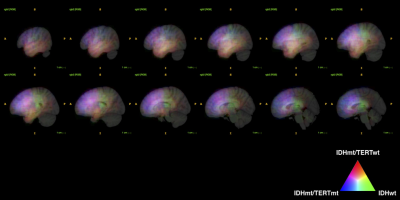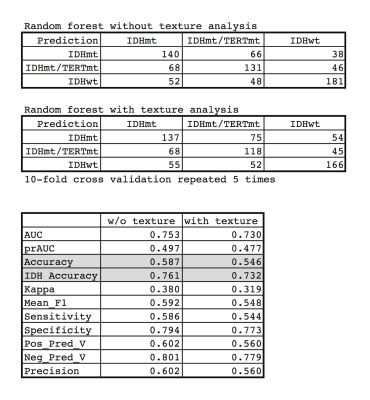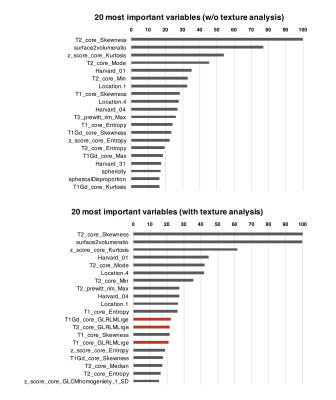0897
Radiogenomics of 154 WHO grade 2 and 3 gliomas via machine learning and the impact of texture analysis1Osaka International Cancer Institute, Osaka, Japan, 2Kansai Molecular Diagnosis Network for CNS Tumors, Osaka, Japan, 3Saga University, Saga, Japan, 4National Cancer Center Hospital, Tokyo, Japan, 5National Cancer Center Research Institute, Tokyo, Japan, 6Osaka National Hospital, Osaka, Japan
Synopsis
In this research, the authors performed radiomics for 154 LrGG and attempted to build a MRI based predictive model to classify clinically relevant 3 LrGG subgroups using machine learning algorithm. The impact of texture analysis such as GLCM and GLRLM on building the model was also investigated. Accuracy for predicting 3 molecular subgroups were 0.587 without and 0.546 with texture analysis. Although radiomics was shown to be a powerful tool to identify genetic subgroups of LrGG, little improvement is expected from texture analysis.
PURPOSE
Genetic alterations found in WHO grade 2 and 3 gliomas include IDH1/2 and TERT promoter mutations and 1p19q co-deletion, which alterations are known to have great impact on the prognosis of the patient. The revised WHO classification for glioma now requires genetic information for accurate pathological diagnosis of the tumor. IDH1/2 and TERT promoter mutations and 1p19q co-deletion are among those required genetic information for WHO grade 2 and 3 gliomas (Lower grade glioma: LrGG). In this research, the authors performed radiomics for 154 LrGG and attempted to build a MRI based predictive model to classify clinically relevant 3 LrGG subgroups using machine learning algorithm. The impact of texture analysis such as GLCM and GLRLM on building the model was also investigated.METHODS
Patients and data collection: 154 LrGGs were retrospectively collected and the genomic DNA of the tumor was sequenced for IDH1/2 and TERT promoter mutations. T2 weighted, T1 weighted, FLAIR and Gd-enhanced T1 weighted images were collected for analysis.
Voxel-based lesion mapping (VLM): T2 weighted images were collected to construct voxel-based lesion maps. T2WI hyperintense lesions were semi-automatically segmented, which process provides the voxels-of-interest (VOI) of the T2WI hyperintense lesions. In the meantime, NIfTI converted T2WI were registered to MNI152 using a mutual information algorithm with a 12-degree of freedom transformation with FSL-FLIRT. VOIs created beforehand were resliced using the affine transformation matrix calculated for registering T2WI to MNI152. All lesions segmented in the group of interest were summed and averaged by the number of patients. A heat-map for the frequency of lesion occurrence was reconstructed and superimposed on the reference MNI152 using in-house developed software using Matlab.
Texture analysis: Histogram analysis of T1WI, T2WI, FLAIR, Gd-enhanced T1WI were calculated within the VOIs was performed. Z-score analysis was also performed for Gd-enhanced T1WI, which analysis reveals the magnitude of regional contrast enhancement similar to a subtraction analysis, and histogram analysis was performed within the VOIs. Furthermore, texture analysis was performed within the VOIs, which measurements were based on both Gray Level Co-occurrence Matrix; GLCM and Gray Level Run Length; GLRLM. Finally, MNI152 registered VOIs were segmented by the MNI152 anatomical template and Harvard-Oxford cortical atlas to provide special information of the lesion.
Statistical analysis: The present LrGG cohort was divided into the following 3 groups; IDH mt/TERTp wt (n=52), IDH mt/TERTp mt (n=49) and IDH wt (n=53). It should be noted that IDH mt/TERTp wt is the hallmark for astrocytoma, while IDH mt/TERTp mt for oligodendroglial tumor. A predictive model for identifying these 3 genetic subgroups was constructed via random forest algorithm with 10-fold cross validation which was repeated 5 times. Two types of model construction were compared, i.e. with and without texture analysis.
RESULTS
VLM revealed that IDH mt/TERTp wt gliomas dominated temporal lobe involvement while IDH mt/TERTp mt occupied the frontal lobe. IDH wt tumors, on the other hand, located at much posterior lobes and centered at the deep white matter (Figure 1). 133 radiomics features including location information was extracted for radiomics without texture analysis and 361 features with texture analysis. 288 features corresponded to texture features based on GLCM and GLRLM. Random forest algorithm was able to build predictive models for identifying molecular subgroups of LrGG (Figure 2). Accuracy for predicting 3 molecular subgroups were 0.587 without and 0.546 with texture analysis. Accuracy for predicting IDH mutation were 0.761 without and 0.732 with texture analysis. Although some texture analysis features were considered as important variables for model construction (Figure 3), no improvement in diagnostic accuracy was achieved with incorporation of texture analysis.DISCUSSION
In this research, the authors were able to confirm that genetic alterations contribute to the locations and radiomic features of the tumor by analyzing 154 LrGG using voxel-based lesion mapping (VLM) and radiomics. Machine learning algorithm such as random forest was useful in constructing a predictive model for identifying genetic subgroups of LrGG. Texture analysis, however, did not contributed to accuracy improvement, which result was contrary to the authors’ expectation. Although radiomics was shown to be a powerful tool to identify genetic subgroups of LrGG, little improvement is expected from texture analysis such as GLCM and GLRLM.Acknowledgements
This research was supported by JSPS, Kakenhi and the Uehara Memorial FoundationReferences
1. Kinoshita M et al: Introduction of high throughput magnetic resonance T2-weighted image texture analysis for WHO grade 2 and 3 gliomas. PLoS One. in press
2. Arita H et al: Upregulating mutations in the TERT promoter commonly occur in adult malignant gliomas and are strongly associated with total 1p19q loss. Acta Neuropathol. 2013 126(2):267-76.
Figures


